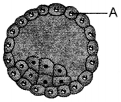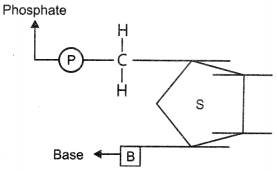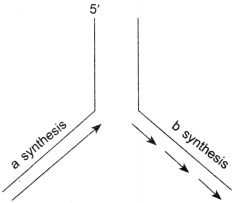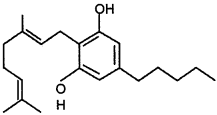Free PDF Download of CBSE Biology Multiple Choice Questions for Class 12 with Answers Chapter 3 Human Reproduction. Biology MCQs for Class 12 Chapter Wise with Answers PDF Download was Prepared Based on Latest Exam Pattern. Students can solve NCERT Class 12 Biology Human Reproduction MCQs Pdf with Answers to know their preparation level.
Human Reproduction Class 12 Biology MCQs Pdf
1. Select the correct sequence of stages of spermatogenesis in a human male.
(a) Spermatogonium → Spermatids → Spermatocytes → Spermatozoa
(b) Spermatogonium → Spennatocytes → Spermatids → Spermatozoa
(c) Spermatids → Spermatogonium → Spermatocytes → Spermatozoa
(d) Spermatocytes → Spermatogonium → Spermatids → Spermatozoa
Answer
Answer: b
2. Vas deferens receives the duct of seminal vesicle and forms the
(a) epididymis
(b) urethra
(c) ejaculatory duct
(d) urethral meatus
Answer
Answer: c
3. How many functional sperms and how many ova will be formed by a primary spermatocyte and a primary oocyte, respectively?
(a) One, One
(b) One, Four
(c) Four, One
(d) Four, Four
Answer
Answer: c
4. Proliferative phase of menstrual cycle, is also called
(a) follicular phase
(b) luteal phase
(c) secretory phase
(d) ovulatory phase
Answer
Answer: a
5. Ovulation occurs under the influence of
(a) follicle-stimulating hormone
(b) luteinising hormone
(c) progesterone
(d) estrogen.
Answer
Answer: b
6. There is no cell division involved in
(a) spermatogenesis
(b) oogenesis
(c) embryogenesis
(d) spermiogenesis
Answer
Answer: d
7. It The cell division in secondary oocyte is suspended at
(a) Anaphase II
(b) Metaphase II
(c) Prophase II
(d) Telophase II
Answer
Answer: b
8. After the release of the secondary oocyte, the Graafian follicle develops into
(a) corpus callosum
(b) corpus albicans
(c) corpus luteum
(d) primary follicle
Answer
Answer: c
9. The outermost layer of a blastocyst is called
(a) ectoderm
(b) mesoderm
(c) endoderm
(d) trophoblast
Answer
Answer: d
10. Urethral meatus refers to the [NCERT Exemplar]
(a) urinogenital duct
(b) opening of vas deferens into urethra
(c) external opening of the urinogenital duct
(d) muscles surrounding the urinogenial duct
Answer
Answer: c
11. Morula is a developmental stage [NCERT Exemplar]
(a) between the zygote and blastocyst
(b) between the blastocyst and gastrula
(c) after the implantation
(d) between implantation and parturition
Answer
Answer: a
12. Spermiation is the process of the release of
sperms from [NCERT Exemplar]
(a) seminiferous tubules
(b) vas deferens
(c) epididymis
(d) prostate gland
Answer
Answer: a
13. Which of the following hormones prepares the uterus for implantation?
(a) Progesterone
(b) FSH
(c) Estrogen
(d) LH
Answer
Answer: a
14. The cell which undergoes meiosis I during spermatogenesis, is the
(a) spermatogonium
(b) spermatid
(c) primary spermatocyte
(d) secondary spermatocyte
Answer
Answer: c
15. Seminal plasma, the fluid part of semen is formed by
(a) seminal vesicle and bulbourethral gland.
(b) bulbourethral gland and prostate.
(c) prostate and seminal vesicle.
(d) seminal vesicles, prostate and bulbourethral gland.
Answer
Answer: d
16. The secondary oocyte completes its meiosis II when a sperm comes in contact with it and forms a large cell, the ______ and a second polar body,
Answer/Explanation
Answer:
Explaination: Ootid
17. The gonadotropin-releasing hormone (GnRH) from the _____ initiates spermatogenesis at puberty.
Answer/Explanation
Answer:
Explaination: Hypothalamus
18. The first movements of the foetus and appearance of hair on the head are observed during the _____ month of pregnancy.
Answer/Explanation
Answer:
Explaination: Fifth.
19. The menstrual phase is followed by _____ phase.
Answer/Explanation
Answer:
Explaination: Menarche.
20. _____ refers to the onset of menstruation at puberty.
Answer/Explanation
Answer:
Explaination: Follicular/Proliferative.
21. The outermost thin membranous part of uterine wall is called ______ .
Answer/Explanation
Answer:
Explaination: Menarche.
22. The part of the fallopian tube, which is closer to the ovary and is funnel-shaped, is called ______ .
Answer/Explanation
Answer:
Explaination: Perimetrium.
23. The cells formed as a result of cleavage of the zygote, are called ______ .
Answer/Explanation
Answer:
Explaination: Blastomeres.
24. The placenta is connected to the embryo through _____ .
Answer/Explanation
Answer:
Explaination: Umbilical cord.
25. The process of delivery of the foetus, is called
Answer/Explanation
Answer:
Explaination: Parturition.
Directions (Q26 and Q27): Match Column I with Column II.
26.
| Column I | Column II |
| Cleavage | 1. Outer layer of the blastocyst that attaches to the endometrium during implantation. |
| Implantation | 2. Mitotic divisions of the zygote in quick succession. |
| Inner cell mass | 3. Embedding of the blastocyst in the endometrium of uterus. |
| Troph oblast | 4. Release of secondary oocyte from the ovary. |
| 5. Group of cells attached to one end of trophoblast that differentiate into embryo proper. |
Answer/Explanation
Answer:
Explaination: A – 2, B – 3, C – 5, D – 1
27.
| Column I | Column II |
| A. Acrosome | 1. Motility of sperm towards the egg. |
| B. Head | 2. Powerhouse of the sperm; contains a number of mitochondria. |
| C. Tail | 3. Contains the genetic material. |
| D. Middle piece | 4. Contains enzymes to dissolve egg envelopes |
Answer/Explanation
Answer:
Explaination: A – 4, B – 3, C – 1, D – 2
28. The finger-like projections, called fimbriae, help in the collection of ovum into the fallopian tube following ovulation. [True/False]
Answer/Explanation
Answer:
Explaination: True.
29. Endometrium undergoes cyclical changes and help in uterine movements. [True/False]
Answer/Explanation
Answer:
Explaination: False.
30. Oxytocin, necessary for parturition, is secreted by the fully-developed foetus and the placenta. [True/False]
Answer/Explanation
Answer:
Explaination: False.
31. The finger-like projections that appear on the trophoblast following implantation, are called chorionic villi. [True/False]
Answer/Explanation
Answer:
Explaination: True.
32. Relaxin is the hormone secreted by the placenta. [True/False]
Answer/Explanation
Answer:
Explaination: False.
Directions (Q33 to Q37): Mark the odd one in each of the following groups.
33. Fimbriae, Labia minora, Infundibulum, Isthmus.
Answer/Explanation
Answer:
Explaination: Labia minora
34. Rete testis, Vasa efferentia, Epididymis, Ampulla
Answer/Explanation
Answer:
Explaination: Ampulla
35. Bulbourethral gland, Prostate. Seminal vesicle, Seminiferous tubule.
Answer/Explanation
Answer:
Explaination: Seminiferous tubules
36. Oogonia, Spermatogonia, Zygote, Ootid
Answer/Explanation
Answer:
Explaination: Ootid
37. Luteinizing hormone, Progesterone, Chorionic gonadotropin, Estrogen
Answer/Explanation
Answer:
Explaination: Luteinizing hormone.
38. Name the cells that nourish the germ cells in the testes. Where are these cells located in the testes? [AI2013C]
Answer/Explanation
Answer:
Explaination: Sertoli cells; they are found in the inner lining of seminiferous tubules.
39. How is a primary spennatocyte different from a secondary spermatocyte?
Answer/Explanation
Answer:
Explaination:
– A primary spermatocyte is diploid and has 46 chromosomes; it undergoes meiosis I and forms two secondary spermatocytes.
– A secondary spermatocyte is haploid and has 23 chromosomes; it undergoes meiosis II and forms two spermatids.
40. Where is acrosome present in humans? Write its function. [AI 2012]
Answer/Explanation
Answer:
Explaination:
– Acrosome is present at the anterior end of the head region of a human sperm.
– It contains enzymes that help in dissolving the envelopes (zona pellucida and plasma membrane) of ovum to facilitate entry of sperm into the cyloplasm of the ovum.
41. Why is the middle piece of human sperm considered as ‘powerhouse of the sperm’? [HOTS]
Answer/Explanation
Answer:
Explaination: Middle piece contains numerous mitochondria, which produce energy for the movement of sperm for fertilisation; so it is called the power house.
42. What is semen?
Answer/Explanation
Answer:
Explaination: Seminal plasma (secreted by the male reproductive glands) along with the spermatozoa, constitute semen.
43. Mention the difference between spermiogen- esis and spermiation, [Delhi 2012]
Answer/Explanation
Answer:
Explaination:
– Spermiogenesis is the process of , transformation of spermatids into
flagellated spermatozoa.
– Spermiation is the process of release . of spermatozoa from the seminiferous tubules of the testes into the ducts.
44. How many primary follicles are left in each ovary in a human female at puberty’?
Answer/Explanation
Answer:
Explaination: 60,000 – 80,000 primary follicles are left in each ovary.
45. List the changes the primary oocyte undergoes in the tertiary follicular stage in the human ovary. [Foreign 2011]
Answer/Explanation
Answer:
Explaination: The primary oocyte grows in size and completes meiosis I and forms a larger cell, the secondary oocyte and a smaller cell, the first polar body.
46. Write the physiological reason, why a woman generally cannot conceive a child after 50 years of age. [AI 2013C]
Answer/Explanation
Answer:
Explaination:
– Menopause, i.e. stoppage of menstrual cycles occurs around 50 years of age; since no ovulation occurs, the woman cannot conceive after this age.
47. Not all copulations lead to pregnancy. Give reason. [HOTS]
Answer/Explanation
Answer:
Explaination:
– The sperm and ovum must reach the ampullary-isthmic junction at the same time, if fertilisation has to occur.
– If the sperms and the ovum are not transported simultaneously to the site of fertilisation, no fertilisation occurs, though copulation has occurred.
48. How does the sperm penetrate through the zona pellucida in human ovum? [Delhi 2013C]
Answer/Explanation
Answer:
Explaination: The sperm penetrates through zona pellucida with the help of secretions from its acrosome.
49. How is the entry of only one sperm and not many, ensured into an ovum during fertilisation in humans? [AI 2012]
Or
During fertilization, hundreds of sperm cells are in the vicinity of an egg cell; but only- one sperm enters the ovum. How is this achieved? [HOTS]
Answer/Explanation
Answer:
Explaination: The changes induced in the zona pellucida of the ovum by the sperm coming in contact with it, block the entry of any other sperm and ensures the entry of only one sperm.
50. What is cleavage?
Answer/Explanation
Answer:
Explaination: Cleavage refers to the rapid mitotic divisions that occur in the zygote.
51. Name the embryonic stage that gets implanted in the uterine wall of human female.
Answer/Explanation
Answer:
Explaination: Blastocyst gets implanted.
52. Identify the figure given and the part labelled “A”.[AI 2011]

Answer/Explanation
Answer:
Explaination:
– It is a mammalian blastocyst.
– A is trophoblast.
53. Mention the function of trophoblast in human embryo. [Delhi 2011]
Answer/Explanation
Answer:
Explaination: Trophoblast forms chorionic villi, which become part of the placenta.
54. What are chorionic villi?
Answer/Explanation
Answer:
Explaination: Chorionic villi are the finger-like projections formed by the trophoblast immediately after implantation; they form the foetal part of the placenta.
55. How is the first sign of growing foetus noticed?
Answer/Explanation
Answer:
Explaination: The first sign of growing foetus is noticed by listening to the heart sounds through a stethoscope.
56. What is meant by gestation period?
Answer/Explanation
Answer:
Explaination: The time period between implantation and parturition, when the embryo completes its growth and development, is called gestation period.
57. State where the signals for parturition arise from, in humans. [AI 2017C]
Answer/Explanation
Answer:
Explaination: The signals for parturition arise from the fully-developed foetus and the placenta.
58. What stimulates the pituitary to release the hormone responsible for parturition? Name the hormone. [AI 2011]
Answer/Explanation
Answer:
Explaination:
– The foetal ejection reflex stimulates the release of hormone for parturition.
– Oxytocin is the hormone.
59. Define Lactation.
Answer/Explanation
Answer:
Explaination: Lactation is the process of feeding the new { bom baby with the milk secreted by the mammary glands.
60. How does the sperm penetrate through the zone pellucida in human ovum?
Answer/Explanation
Answer:
Explaination: The sperm penetrates through zona pellucida with the help of the secretions from the acrosome.
We hope the given Biology MCQs for Class 12 with Answers Chapter 3 Human Reproduction will help you. If you have any query regarding CBSE Class 12 Biology Human Reproduction MCQs Pdf, drop a comment below and we will get back to you at the earliest.





